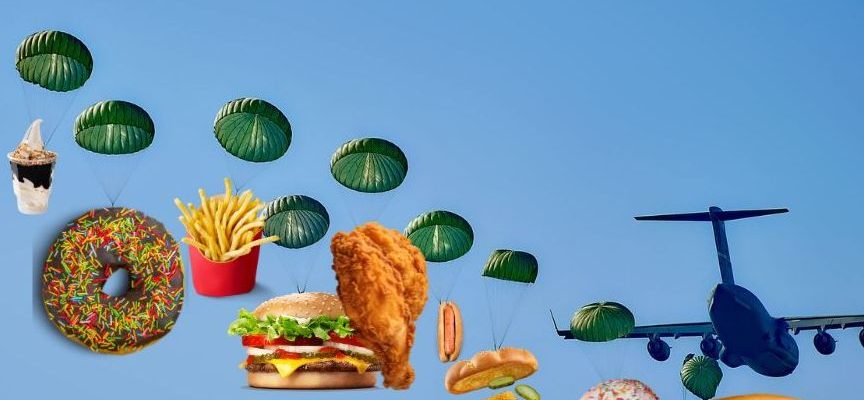Forget beef bourguignon, ratatouille and the “Croissant versus pain au chocolat” debate. Catering in France has an air of Omaha Beach, with an ever-increasing number of American franchises arriving. In the last ten years alone, count the arrival of Steak’n’shake in 2014, Five Guys in 2016, Carl’s Jr in 2018, Popeye’s in 2023, and the latest, Krispy Kreme and their donuts this Wednesday. A tiny decade for so many new faces, where in the past, more than ten years were necessary between the arrival of each new juggernaut “born in the USA” : McDonald’s made its French debut in 1979, KFC in 1991 and the return of Burger King to our territory dates back to 2012.
For Clémentine Hugol-Gential, professor and specialist in contemporary food issues at the University of Burgundy, the explanation lies directly in the taste buds of the French. It’s not so much America that sells as the flagship products offered in these establishments – the burger (McDo, Burger King, Five Guys and Steak’n’shake) and the chicken (the KFC and Popeye’s duopoly).
Very popular products
For the first city, France is in the middle of burger mania: sales have increased 14-fold in ten years, says Bernard Boutboul, president of Gira Conseil and catering expert. And don’t see it as just the prerogative of fast food restaurants, quite the contrary. Their monopoly is even seriously crumbling: 95% of the French burger market in 2008 to “only” 70% in 2023. Restaurants have also understood the trend, and 80% of them now offer a steak between two slices. of bread.
Same success story for chicken: its consumption increased by another 5% between 2021 and 2022 in France, making it the European country most fond of poultry ahead of Germany and Spain. The Frenchy consumes on average fifteen chickens per year, or more than 28 kg. Such a breakthrough is also visible for the donut, Krispy Kreme’s new flagship product. “They are more and more present in bakeries, at Starbucks, not to mention pop culture with obviously Homer Simpson, but also multiple series,” underlines Clémentine Hugol-Gential.
The land of gastronomy, really?
Products sometimes far from the refined image of the country of gastronomy. But for Pierre-Louis Desprez, managing director of Kaos, a firm specializing in marketing, it would also be a question of stopping lying to ourselves: “There is the imagination of grandmother’s cooking in copper cauldrons and French locavores and lovers only of homemade recipes, and there is reality. McDonald’s is a hit, kebabs are a hit, tacos are a hit… There is a place for the French market for what we call “junk food” and fast food. »
In particular, beyond the question of fat, for obvious reasons of price, accessibility and speed of service, recalls the expert. But be careful, because behind all these arguments, American success in France over the past ten years cannot be put into perspective.
A slightly missed landing
Landing in France is good, really establishing yourself there is better. Behind the three locomotives (more than 1,500 McDonald’s in France, nearly 500 Burger King and more than 300 KFC), American expansion looks more like a turtle than Attila. After eight years on site, Five Guys only has twenty-nine restaurants throughout the country, including twelve in Ile-de-France. A little weak when the French general manager at the time, Vincent Lemaître, announced in 2019 his intention to “open around ten restaurants per year”. Present in France for five years, Carl’s Jr has only opened seven establishments. And when it doesn’t stagnate, it falls. Steak’n’shake only has sixteen restaurants in France, compared to twenty-six in 2020. For an invasion, we have seen better.
Bernard Boutboul offers a clear observation: “France is de-Americanizing. American brands, with the exception of the top three, are not successful and are having a hard time establishing themselves. » And even among the dominant ones, it was necessary to adapt to this very specific market that is France and its gastronomy. Just look at the strategy of the number 1 American brand here, McDonald’s: erase its star-spangled banner side as much as possible and embrace the cockade.
The Frenchification of McDonald’s, a symptom of a very specific market
“For more than a decade, McDonald’s has become extremely French. Presence at the agricultural show, premium burger with cutlery, table service, Made in France product, Mcbaguette, change from red to green signs,” lists Bernard Boutboul among other examples.
Pierre-Louis Desprez qualifies his own remarks: “France remains a very particular food market, with above-average demands and very strong competition. » With everyone wanting a piece of the French cake, the market for burgers or chicken, certainly promising, is becoming saturated. “If so many brands fail, it’s because the space is already taken. Only Burger King has been able to join the McDonald’s wagon, and even then with an ultra-offensive entry strategy, and by remaining eternally second,” continues Bernard Boutboul.
With the difficulties of some, and the forced Frenchification of others, it remains to be seen why so many still want to cross the Atlantic for several years. “No doubt seeing other companies struggling makes them believe that they can do better, and succeed,” believes the president of Gira. An optimism that fits well with Krispy Kreme. The brand plans to sell 32,000 donuts this Wednesday, and wishes to distribute its products to nearly 500 points of sale within five years.

